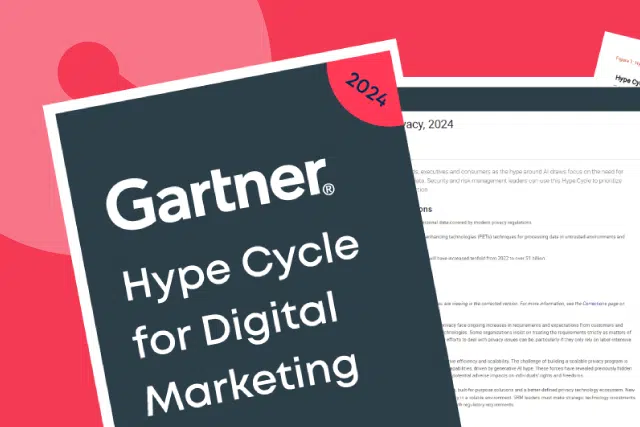5 new strategies for a cookieless future
Posted: April 28, 2023
In recent years, the marketing technology (martech) industry has undergone tremendous growth, driven by the abundance of customer data and analytics that are now available. This data has enabled companies to create more personalized advertising and customer communication, enabling them to build stronger relationships and trust. However, this increased access to data has also come with new regulatory challenges that have made it increasingly difficult for marketers to keep up and adjust their strategies to stay competitive.
To remain compliant with today’s strict regulations, marketers must work in tandem with compliance and data architecture teams. It is no longer enough for marketers to only use traditional methods for managing customer data; rather, they must collaborate with other departments to ensure that all goals are being met while still respecting customers’ privacy. Ultimately, a marketer’s primary objective is driving revenue; however, as consumer attitudes towards data and consent evolve, marketers must be able to adapt quickly to ensure they are communicating the right messages in a compliant manner while still hitting their targets.
The world of marketing is in a state of flux as consumers become increasingly concerned with protecting their privacy and data security. According to recent research, a whopping 72% of people will avoid doing business with any company they don’t trust to keep their information secure. On top of this, 87% believe the United States should do more when it comes to protecting consumer data privacy.
At the same time, customers are demanding more personalized experiences. The same study found that 42% of people are likelier to shop with a brand that offers them tailored and personalized experiences.
Exploring the future of Martech
The move to a cookieless world is drastically changing the way martech professionals will reach new customers in the future. This shift is being driven by several factors, including Big Tech’s efforts to get ahead of regulations and build their own data ecosystems, changing public sentiment around cookie tracking, and new U.S. privacy laws similar to GDPR in the U.K.
This transformation presents an important opportunity for companies—they can either seize this moment to refine their marketing approach or be forced into compliance without a strategy. For those who understand the changes occurring in AdTech and are open to newer approaches, they will be able to not only stay ahead of the curve but become leaders in their organization and industry as well.
New approaches to marketing
As the digital marketing landscape continues to evolve, marketers are being presented with an unprecedented challenge: planning for a cookieless future. Google’s announcement that it will be phasing out third-party cookies by 2024 has sent shockwaves throughout the industry, prompting marketers to devise strategies that allow them to gather customer and prospect data without compromising compliance and user privacy.
First-party data is king
As the digital landscape continues to evolve, so too does the importance of building trust through first-party data collection. Recent research has revealed that customers want to know more about what information is collected and why. An impressive 95% of surveyed consumers have expressed a belief that individual brands and companies should take greater responsibility in their privacy practices, with 75% wanting increased transparency on data collection and usage. To stay ahead of the curve, companies must update their consent approaches to ensure they are consistently communicating with their customers in a transparent manner. Doing so will not only help them remain compliant with privacy laws, but also give them a competitive edge by cultivating trust between themselves and their consumers before these steps become mandatory.
In addition to the existing methods of first-party data collection, such as tailored surveys, many marketers are turning to advanced technologies like chatbots and AI solutions to gather insights into prospective customers. By leveraging these tools, brands can gain a better understanding of customer needs and preferences while remaining compliant with privacy regulations. Through this data-driven approach, they can create more personalized experiences for their users while still protecting customer privacy.
Aligning with the Big Five
The five largest tech companies in the United States hold a great deal of control over the data that is collected and used for marketing purposes. In order to prepare for a cookieless future, marketers must understand the strategies employed by these companies, such as Google’s new Federated Learning of Cohorts (FloC) advertising approach. FloC is designed to enable “interest-based advertising on the web” while still respecting user privacy. Companies should also be aware of Apple’s Mail Privacy Protection (MPP) and understand what data they can no longer access to get full value from email campaigns.
How marketers can collect data compliantly and avoid data privacy lawsuits
Marketing teams should be upfront and transparent about how they collect customer data and ensure that customers have the ability to decide what information to share. This can give them an advantage over their competitors, as well as help them stay ahead of privacy laws such as those in Iowa, California and Colorado that are introducing additional consumer protection guidelines. Cassie’s research shows that 82% of consumers are more likely to opt-in for data sharing when companies operate with more transparency.
Recent headlines around TikTok’s CEO being taken to trial only reinforces the necessity for stringent consumer data policies, as the popular platform is accused of spreading disinformation and exposing US consumer data. Going forward, ad-tech and marketing strategies must adapt quickly to keep up with new laws and regulations or risk facing financial costs due to class action lawsuits, as well as reputational damage.
Marketers need to find innovative ways to gather third-party data outside of websites and social media platforms in a post-cookie world. It will become increasingly important for marketers to learn how to collect customer data responsibly while obtaining consent from customers in order to provide personalized content in a safe manner. To minimize risks associated with non-compliance on privacy policies, it is crucial that marketers create an audit trail which documents all steps taken with regards to collecting customer data.
Cassie’s first-party cookie solution empowers marketers
Changes imposed by browsers make it difficult for marketers to identify and track returning website visitors.
It’s essential for marketers and website owners to understand the implications of Intelligent Tracking Prevention (ITP) and Enhanced Tracking Protection (ETP) on their web traffic. By better understanding these features, you can adjust your marketing efforts and keep your website performance at its best.
Cassie respects users’ consent whilst offering businesses a way to identify returning visitors even when browsers or users have deleted cookies.
Cassie’s ITP calculator will provide you with accurate data that shows you exactly how ITP and ETP are affecting your web traffic.
Cassie helps you tackle the ITP challenge and retain as much user data as possible.

Want to learn more about ITP?
Read our ITP and cookies guide for a comprehensive overview of ITP and how the latest Safari browser update will impact your site’s cookies.

